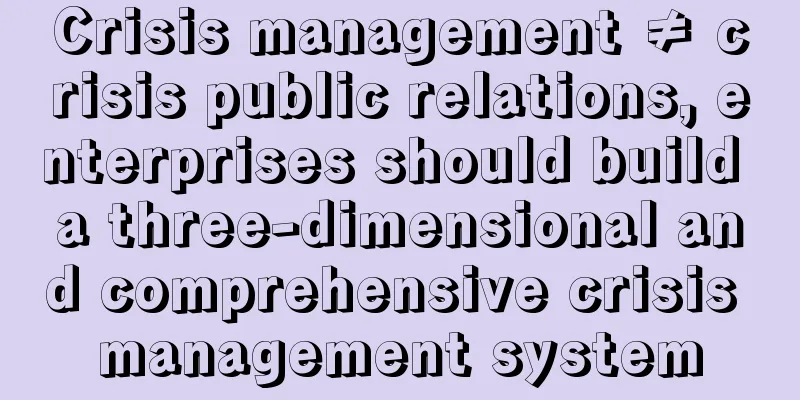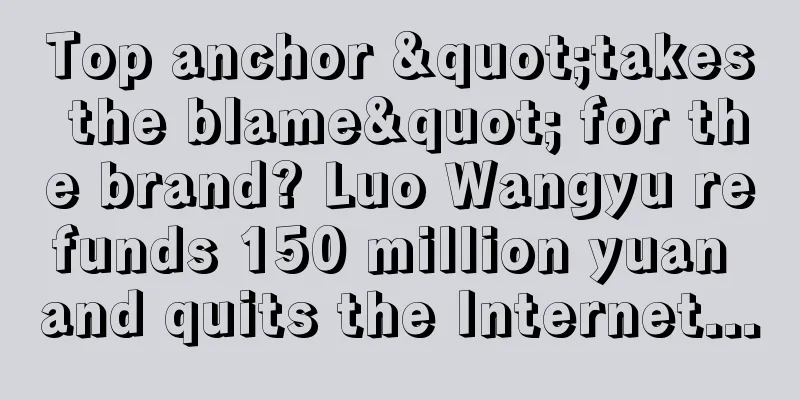Crisis management ≠ crisis public relations, enterprises should build a three-dimensional and comprehensive crisis management system

When an enterprise encounters a public opinion crisis, it is also the day of suffering for public relations practitioners. Not only do they have to work day and night to deal with it, but they often also have to deal with internal "blames": it is because of the ineffective crisis public relations that the enterprise has suffered such a huge loss! This is undoubtedly an unreasonable accusation and an extreme fallacy, and it also reflects a widespread misunderstanding: crisis management is crisis public relations. In fact, the emergence and evolution of crises cannot be controlled and dealt with by the public relations department alone. Enterprises should build a three-dimensional and comprehensive crisis management system to enhance their ability to resist crisis risks. In fact, except for a very small part of the crises encountered by enterprises that are directly evolved from the collision and conflict between advertising, public relations or other marketing work and public opinion, most of the rest are caused by loopholes in various links of business management. Whether it is procurement, production, sales, marketing, customer service and other links facing the external market or internal management work such as personnel, administration, and legal affairs, they are all closely related to the business management and brand reputation of the enterprise. Any small negligence or problem in these links, if not handled properly, may gradually magnify and evolve into a crisis, posing a serious threat to the survival and development of the enterprise. When the crises in various links are paid attention to and hotly discussed by public opinion, they will multiply the destructiveness exponentially like an earthquake. Crisis public relations is merely a measure to control the expansion of destructiveness at the public opinion level. Enterprises must realize that "crisis management ≠ crisis public relations" and should actively build a comprehensive and three-dimensional crisis management work system, and based on this system, implement strong crisis management of all internal and external links, strive to nip potential risks in the bud, and be able to properly handle and respond to a crisis even if it really occurs. This crisis management work system must at least include mechanisms and tools such as the establishment of crisis management personnel, crisis classification and response plans, and crisis monitoring systems. Through training and drills, this system should be able to operate efficiently, integrating crisis management into daily operations to eliminate potential risks, promptly detect and properly handle crises, and ensure the steady development of the company. First of all, companies should plan for crisis management personnel and clearly define the responsibilities and powers of crisis management that senior executives, middle-level managers, and front-line employees should assume in different departments and positions to ensure clear division of labor and equal rights and responsibilities. Secondly, enterprises should classify and grade crises and formulate corresponding disposal plans. Classification and grading requires the classification and grading of crises based on regulatory laws, production methods, sales methods, etc., so that enterprises can formulate corresponding plans according to different crises; crisis response plans should be pre-planned disposal plans for crises of different types and levels, and clarify the corresponding management departments, communication mechanisms and disposal measures. Enterprises can activate the plan as soon as the crisis occurs and respond reasonably to minimize the negative impact. Thirdly, the crisis monitoring system includes public opinion monitoring system, production safety monitoring system, product quality control system, customer complaint system, etc., which can help enterprises detect crises as early as possible and deal with them in a timely manner to prevent them from evolving into a larger crisis or spreading into a public opinion crisis. In addition, after the crisis management system is established, the company should formally release and implement it in the form of a document, put it into operation through learning and training, online operation and assessment and evaluation, integrate it into all internal and external links of the business process, and make it a part of daily business management. For their internal business activities, enterprises must comply with laws and regulations as the cornerstone of their operations, continuously optimize internal management processes in various links such as production, sales, and services, ensure the quality of products and services, monitor and eliminate potential risks and hidden dangers, and quickly initiate crisis management plans to respond appropriately when risks occur. External risks mainly come from partners such as suppliers and distributors. Enterprises should strictly control the qualifications of suppliers and distributors, understand their business management, and take immediate measures when violations are found, including termination of cooperation and accountability. In addition, enterprises should establish smooth and efficient communication with partners so that when a crisis occurs on any side, the enterprise can respond quickly and take the initiative, master sufficient information and formulate reasonable crisis management strategies. In summary, crisis management is a systematic project and is not limited to crisis public relations. Enterprises must build a comprehensive and three-dimensional crisis management system, improve internal management level to eliminate their own potential risks, strengthen external risk management to avoid being involved in the crisis vortex, and escort the steady development of the enterprise. Author: Chen Hao |
>>: How to quickly increase sales of new products? 3 high-exposure sales templates are included!
Recommend
Does Amazon have almost no orders without advertising? How to get orders?
Amazon is a very popular cross-border e-commerce p...
Say goodbye to routine analysis and explore infinite possibilities with your mind
In different scenarios, the process of data analys...
How does Amazon handle holidays during the Chinese New Year? How do you handle holidays during the holidays?
Basically, whether or not the e-commerce platform ...
How long does it take to review Amazon brand registration? What information does Amazon require?
Nowadays, everyone wants to open a store on Amazon...
You have never worked in our industry, so why are you qualified to provide me with marketing consulting?
Have you ever had the following questions: Why do ...
Fall in love with the tea drinks of joint brands, but the joint brands are mainly "hard to drink"
Cross-border collaboration is the most popular bra...
How long is the payment cycle of Amazon? How to collect payment?
Merchants who open stores on Amazon know that they...
Where can I see the click-through rate of Amazon ads? How can I improve it?
Everyone is familiar with Amazon. Many people have...
Starbucks awaits long recovery
Faced with increasingly fierce competition and pri...
In 2024, who will still be shopping in the live broadcast rooms of big anchors?
This year, the popularity of major live-streaming ...
Does Amazon charge for not placing an order for its flash sales? How much does it charge?
There are many activities on the Amazon platform f...
For those who know sales best, why is it still so difficult to build a brand?
In the e-commerce arena, brands and platforms are ...
There's another wave of Children's Day? Adults fight with children for toys at KFC
Through the hot sales and consumer response of the...
How can I cancel the contract between Baofu Payment and my bank card? Which online loan company deducted the payment from Baofu?
In some cases, users may need to terminate the con...
Is Amazon cross-border e-commerce easy to do now? What is the situation?
Now many of my friends are doing cross-border e-co...









